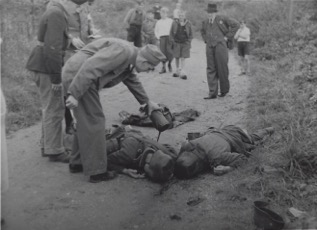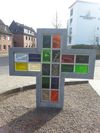

|
|
|
|
|
|
Limburg 1940-1945,
Main Menu
1940-1945 - The Germans killed in action in Valkenburg-Houthem
- German Front Soldiers
- German soldiers who died in the municipality of Valkenburg-Houthem. Of these, 13 are buried as unknown soldiers in Ysselsteyn. They are called NN here.
- Valkenburgers who were drafted into service because they were of German descent.
- Some Dutch volunteers from Valkenburg.
- A war criminal. Unlike the people mentioned above, this one survived.
- The documents from the archives of the municipality of Valkenburg a/d Geul
- Photographs of an identification team from Maastricht at work on September 16, shortly after the liberation of the southern part of Valkenburg.
- Correspondence with parents, a pastor and various authorities about the fallen and their graves
- The “battle” on the Goudsberg
Although it is called that, the German troops didn’t stand a chance. A short time later, the whole of South Limburg was liberated and the Battle of Aachen began.

Sept. 16th, 1944 - Two dead Germans in Valkenburg. Source: Municipal archives.
This website has been set up primarily to commemorate the dead of the resistance in Dutch Limburg against the Nazi occupation. One focus is the history of Valkenburg during this time. In it also others are mentioned, we try at least for Valkenburg to name all who played a role during WWII. Of the resistance also the survivors, the important non-resistors, even the pro-Germans among them. Furthermore, the Jews who lived here, also the survivors among them, as well as the Allies who died in our municipality. We have tracked down all of them, or at least almost all of them. At least their names, but often also a story and sometimes a photo.
Now we have begun the most difficult part: Who were the German soldiers? Finding out the details behind the names of fallen Germans proves to be much more difficult than with the other groups. Often, not even their names are known because their identification tags have been lost. The Germans who fell in the Netherlands are or were all buried in the German military cemeteries in Ysselsteyn (municipality of Venray) or Lommel (Belgian province of Limburg). [1]
The most detailed research to date on the German soldiers killed in Valkenburg was made by Jan Diederen. He published his findings in his book Mijn oorlog en bevrijding. [2]
On page 10 he quotes the journal of the Aachener Geschichtsverein (Aachen History Society) [3], which states that the 275th and 41st German Infantry Divisions had taken up a combat position between Meerssen and Wittem on the north bank of the Geul from September 13, 1944. They belonged to the 81st Army Corps under Lieutenant General Friedrich August Schack. [2]
Once Valkenburg was liberated, the U.S. forces advanced from Valkenburg toward Heerlen and Aachen on September 17, 1944, including via the Steenweg. On the Goudsberg [5] they encountered resistance from a German unit entrenched there, firing from four machine gun nests. They had no chance against the seven American tanks of the 743rd Tank Battalion, which had been attached to the Old Hickory division and here, for one of the few times, we received and welcomed air support. Three dive bombers did a beautiful job of removing for machine gun nests which were holding us up. [2.1]
By the way, because of the favorable location on the hill, the Romans already had a watchtower there. [6]
When the US forces moved on, 63 of these men were no longer alive. This is the largest group of Germans killed in the then municipality of Valkenburg-Houthem.
Jan Diederen wrote at p.75 under the title German losses: [2]
After the Battle of the Goudsberg, it is possible to take stock of the German losses at Valkenburg during the three-day battle with the Americans.
The casualties were: one in IJzeren, one in Schin op Geul and six in Houthem according to the records in the Valkenburg archives. The one from IJzeren was buried in a field grave, the others in local cemeteries. However, 11 fallen soldiers from Houthem were also reburied in a temporary German cemetery in Neerrepen/Overrepen, so they are not recorded in Valkenburg. At the cemetery on the Cauberg, 21 German soldiers are buried and therefore also registered.
A much larger number of 335 German soldiers were taken prisoner. The exact number can be found in the ‘After Action Report’ of the commander of the 119th Regiment, Lieutenant Allen S. Hubbard, for the month of September 1944.
On September 14, 73 prisoners were counted, on the 15th sixteen, while a complete group of 120 men also surrendered, and on the 16th twenty-two. On September 17, 104 German soldiers surrendered.
As the Americans were already advancing from Valkenburg at eight o’clock in the morning and only encountered resistance at the Goudsberg, it can be assumed that they were, as police chief Jan Franssen vividly put it, ‘rushing towards the tanks with their hands raised, much higher than the Hitler salute and unarmed’.
With 133 killed and 335 taken prisoner, a total of 468, this was a heavy loss for the German army.
The identification tags or dog tags [7] are important for the identification of the wearer in any war. Those of the Wehrmacht also stated to which unit the soldier belonged at the time the tag was issued.
- nl: oorlogsslachtoffers.nl Duitse militaire begraafplaats Ysselsteyn
de: oorlogsslachtoffers.nl Deutscher Soldatenfriedhof in Ysselsteyn (Gem. Venray)
de: kriegsgraeberstaetten.volksbund.de Friedhof Ysselsteyn
OpenStreetMap - ††† Lommel Dodenveldstraat 30, B-3920 Lommel
- nl: oorlogsslachtoffers.nl Duitse militaire begraafplaats Ysselsteyn
- Jan Diederen Mijn oorlog en bevrijding.
1. p.15. Quoted from the war report of the 119th regiment. - Poll, Das Schicksal Aachens im Herbst 1944; Zeitschrift des Aachener Geschichtsvereins. Band 66/67. Jahrgang 1954/1955. Festband aus Anlaß des 75jährigen Bestehens
- Gemeentearchief Valkenburg
- Onlineprojekt Gefallenendenkmäler - von Ahnenforschern für Ahnenforscher
- wikipedia NL Wachtpost Goudsberg
- Wikipedia • Identiteitsplaatje • Erkennungsmarke • Dog tag • Plaque d’identification militaire • Chapa de identificação
